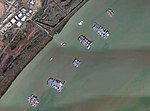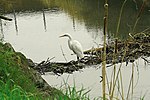Pacheco Creek (Contra Costa County)
California river stubsContra Costa County, California geography stubsRivers of Contra Costa County, CaliforniaRivers of Northern CaliforniaTributaries of San Pablo Bay

Pacheco Creek is a 3.4-mile-long (5.5 km) waterway in central Contra Costa County, California, United States. It empties into Suisun Bay. It is formed by the intersection of Walnut Creek, Grayson Creek and Pine Creek. The creek has a run of chinook salmon and steelhead trout after periods of rain in the winter and fall.
Excerpt from the Wikipedia article Pacheco Creek (Contra Costa County) (License: CC BY-SA 3.0, Authors, Images).Pacheco Creek (Contra Costa County)
Waterfront Road,
Geographical coordinates (GPS) Address Nearby Places Show on map
Geographical coordinates (GPS)
| Latitude | Longitude |
|---|---|
| N 38.044365 ° | E -122.092465 ° |
Address
Waterfront Road
94553
California, United States
Open on Google Maps







